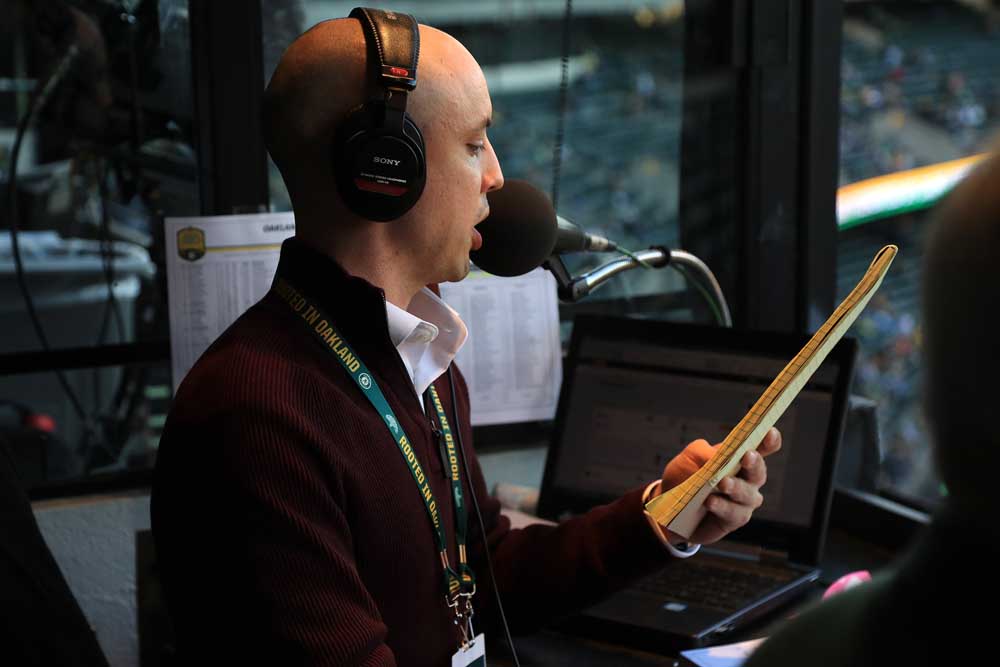Now finally announcing for the Oakland Athletics, Donny Baarns
Published 12:00 am Tuesday, September 4, 2018

- Donny Baarns reads an intro while announcing an Oakland A’s game at the Oakland Coliseum on Friday. Baarns, a longtime minor league baseball announcer, fulfilled his dream of announcing for a major league game. (Jim Wilson/The New York Times)
OAKLAND, Calif. — The dream he had pursued for most of his life was a few seconds from being fulfilled, but instead of betraying nervousness, Donny Baarns was a picture of focused calm.
He looked out at the lush baseball field below his broadcast booth, at the outfield flags blowing westward, at the players loping to their positions.
He listened though his headset for his signal to start. He breathed in deeply, leaned toward his black microphone and spoke.
“With Vince Cotroneo and Ray Fosse, I’m Donny Baarns here at the Coliseum, as we get set for the Oakland Athletics and the Seattle Mariners on this Friday night …”
By speaking those words, he had made it to the big leagues as a game announcer — at long last.
During the last 10 years, Baarns has broadcast more than 1,000 minor league baseball games, from the dusty towns of California’s Central Valley to the windswept heart of the Midwest. An article in The New York Times in June chronicled his journey: how he grew enamored of baseball announcing as a boy listening to Vin Scully, the famed Los Angeles Dodgers announcer; how he worked for years in a low-paying job as the voice of the Visalia Rawhide, in the Class A California League; how he is still at it, like dozens of other announcers in the minors, pining against the odds for a rare job in the big leagues.
The dream has taken Baarns most recently to Nebraska, where he now calls games for the Omaha Storm Chasers in the Class AAA Pacific Coast League.
What Baarns hoped for all these years was a full-time job in the majors. But he is also aware of the minor league legends who never announced even a single big league game. The chance to man the booth for the Seattle-Oakland game meant he would always be able to say he at least got a taste.
The Oakland A’s president, Dave Kaval, provided the opportunity. Kaval, who in two years on the job has gained a reputation as one of baseball’s most out-of-the-box executives, read the Times story with particular interest. Baarns, after all, has announced spring training games over the internet for Oakland since 2014.
As he read, Kaval came up with a plan: Find a way to bring Baarns to Oakland for a late regular-season game, and let him realize his dream. There was an opening: Ken Korach, the team’s lead broadcaster, was due for a night off in late August. A few days later, the deal was done.
“It was like, ‘boom, boom, boom,’ the next thing you know, this is happening,” Kaval said. “We always move quickly around here.”
So it was that Baarns found himself in Oakland on Friday — and not just for any game. This was a contest with playoff stakes for two long-moribund teams having surprisingly successful seasons. “When they called me in June, the A’s were about 10 games out and the season seemed lost,” Baarns said as he walked the grounds before his broadcast began. “Now they’re close to winning their division, and I get to call a game in the middle of a pennant race. Who would have thought?”
Baarns — 34, bald, with a youthful face and a resonant voice — was so concerned about doing a good job that in preparation he had studied the stadium’s wind patterns and sightlines, worried that he might misjudge a line drive and give listeners the wrong sense of an unfolding play. He started studying both teams weeks before the game, listening to podcasts, reading about their surges and disappointments (the Mariners faltered after the All-Star break but still cling to contention; the A’s remain one of baseball’s hottest teams).
Baarns called Korach, a longtime mentor, and got an insider’s scoop on the A’s. He received emails from Cotroneo, Korach’s radio partner. Both had similar advice: Have fun and be loose, they said. Just do what you’ve always done. Most of all, trust your stuff.
It helped that the game turned out to be stacked with action. In the first inning, the A’s scored five times, but Cotroneo, leading the broadcast call for this game, described the action, as is customary.
By the fourth inning, however, Baarns had the lead chair, just in time for the Mariners to launch a sustained attack on Oakland pitcher Mike Fiers, starting with Robinson Cano at the plate.
“Fiers turns with the right foot,” Baarns said, “kicks with the left, around comes the arm, and it is swung on and drilled, deep to right field. Back on it goes to Piscotty. He is at the wall and out of room and it is gone. A solo home run.”
Next up, Nelson Cruz. “Here’s a fastball, rocketed toward deep left-center. That’s way back there, Laureano sprinting into the alley, climbs the wall, it’s gone!”
Soon, the Mariners’ Ryon Healy stood at the plate: “Here’s the pitch, lined deep toward center field, way back, toward the wall, and that ball is gone! The Mariners are playing pepper with that State Farm sign, above the wall in right field.”
Three home runs in half an inning. Action is what Baarns had hoped for in this game, and action is what he got — along with a lot of good-natured ribbing in the booth.
“Donny, we give you a four-run lead and you can’t hold it!” Cotroneo barked, off the air, after the Mariners had tied the score in the fourth. The veteran broadcaster had been cracking wise behind the scenes from the start, easing any tension Baarns might have felt. (At one point, he turned to Baarns and advised: “Donny, if you really want to make a name for yourself, start cursing immediately.” Baarns laughed, then deadpanned back that it was great advice.)
In the end, the A’s won, 7-5. Baarns led the broadcast for nearly half the game. Once it was done, Cotroneo gave him a warm, welcome-to-the-bigs hug. “Nice job, buddy,” Cotroneo said. “You sounded just great.”
The stadium began closing down. Only a few straggling fans were left in the stands. The groundskeepers swept up the basepaths and tended the grass. Baarns packed up his bags and put away his microphone, which he had brought with him from Omaha.








